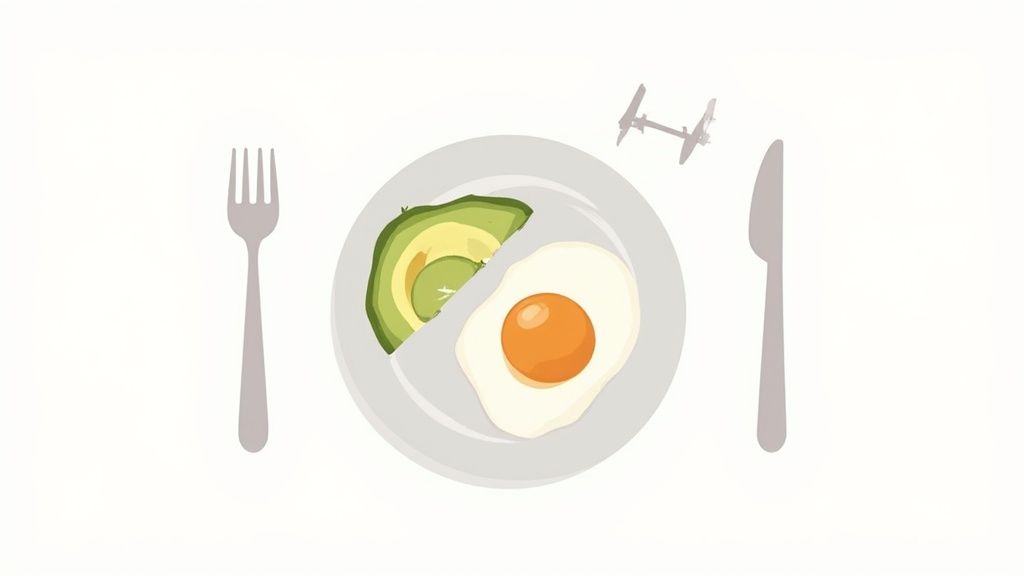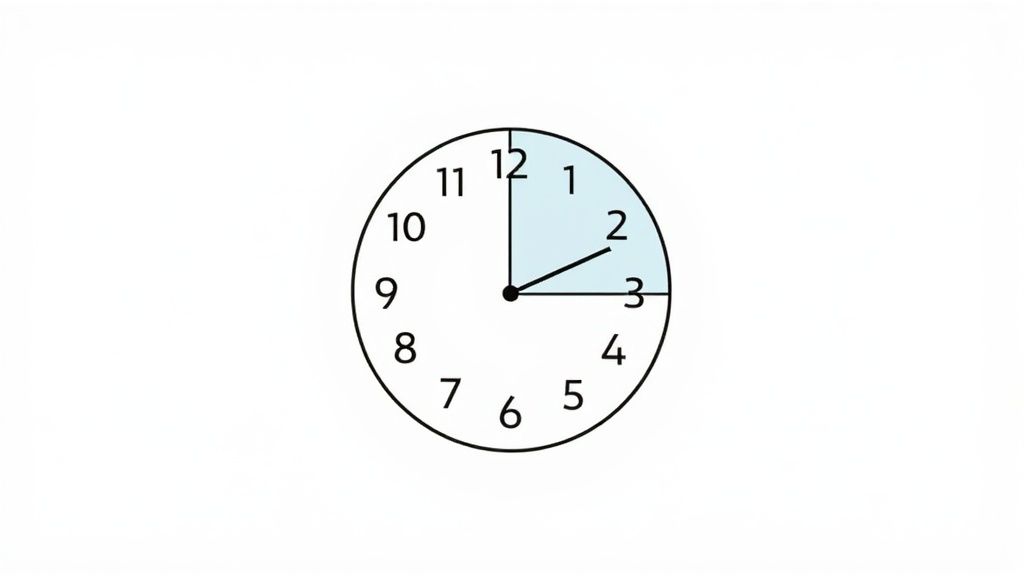8 Practical Ways to Get Sugar Cravings Help in 2025

Sugar cravings can feel like an unbeatable enemy. One moment you're committed to your health, and the next, you're battling an intense urge for something sweet. This isn't a failure of willpower; it's a complex biological response involving hormones, brain chemistry, and deep-seated habits.
Processed foods, packed with refined sugars, are designed to hijack our natural satiety signals. This creates a powerful cycle of craving, consumption, and crashing that leaves many feeling out of control and constantly searching for a fix. Understanding the "why" behind your cravings is the first step toward regaining control.
This guide provides practical sugar cravings help by breaking down eight powerful, science-backed strategies. You will learn how to manage these urges, stabilize your energy, and take back command over your health choices. We'll also show how tools like the StopSugar app can support your journey, helping to turn these expert strategies into sustainable, long-term habits. Get ready to transform your relationship with sugar, one practical step at a time.
1. Strategy 1: Win the Morning with a Protein-Rich Breakfast
How you start your day often dictates how you will end it, especially when it comes to managing sugar cravings. A breakfast high in simple carbohydrates and sugar, like a pastry or sweetened cereal, sets you up for a blood sugar rollercoaster. This cycle of spikes and crashes is a primary driver for intense, hard-to-ignore sugar cravings later in the day. The solution is to win the morning by prioritizing protein.

Starting your day with a substantial amount of protein, ideally 20 to 30 grams, provides powerful sugar cravings help by stabilizing your blood glucose from the very first meal. Protein digests slowly, which promotes a feeling of fullness (satiety) and requires more energy from your body to break down. This process helps maintain steady insulin levels, preventing the dramatic energy dips that leave you reaching for a quick sugar fix. This principle is championed by experts like functional medicine physician Dr. Mark Hyman and is a cornerstone of successful programs like Precision Nutrition.
How to Implement This Strategy
Making the switch to a high-protein breakfast doesn’t have to be complicated. The key is planning and preparation. Here are some actionable tips:
- Prep Ahead: Boil a batch of eggs at the start of the week. Portion out Greek yogurt into grab-and-go containers. Cook some chicken sausage or turkey bacon that you can quickly reheat.
- Combine with Fiber: Enhance satiety by adding fiber-rich foods to your protein. Think spinach and mushrooms in your omelet, or a handful of berries and chia seeds in your Greek yogurt.
- Use a Quick-Fix Smoothie: If you’re short on time, blend a scoop of quality protein powder with unsweetened almond milk, a handful of spinach, and half an avocado for a balanced, filling meal.
- Track Your Intake: For the first week, use a tool like the StopSugar app to track your protein intake. This helps you understand what 20-30 grams actually looks like and ensures you’re hitting your target consistently.
2. Mindful Eating and Craving Awareness
Sugar cravings often feel like an automatic, overpowering command that you must obey. This reaction is a deeply ingrained habit, but it’s one you can change by creating a pause between the craving and your response. This is the core of mindful eating, a practice that develops conscious awareness of your internal signals, helping you understand triggers and respond thoughtfully instead of reactively.

By applying mindfulness, you learn to observe a craving without judgment, transforming it from an urgent demand into a piece of information. This powerful technique offers significant sugar cravings help by breaking the cycle of mindless eating. Pioneers like Dr. Jon Kabat-Zinn and Dr. Susan Albers have demonstrated its effectiveness, and it's a key component in programs at institutions like Stanford Medical Center and even integrated into corporate wellness at places like Apple. It empowers you to choose your actions, giving you control back from your impulses.
How to Implement This Strategy
Integrating mindfulness doesn't require hours of meditation; it starts with small, intentional moments of awareness throughout your day. Here are a few practical ways to begin:
- Practice the STOP Technique: When a craving hits, use this acronym: Stop what you're doing, Take a deep breath, Observe the feeling (is it physical hunger, boredom, stress?), and Proceed mindfully with a conscious choice.
- Keep a Craving Journal: Use the journal feature in the StopSugar app to log when cravings occur. Note the time, your emotional state, and what was happening. This helps you identify patterns and triggers you were previously unaware of. You can learn more about specific techniques in our guide to mindful eating exercises.
- Start with Mindful Bites: You don’t have to be mindful for an entire meal at first. Begin by eating the first three bites of your food with full attention. Notice the taste, texture, and smell. This small practice builds the muscle of awareness.
- Use Guided Meditations: Apps like Headspace or Calm offer short, guided meditations focused on cravings and mindful eating. Just a few minutes a day can help train your brain to be less reactive.
3. Strategic Hydration with Electrolytes
One of the most overlooked triggers for sugar cravings is simple dehydration. Your body often sends mixed signals when it's low on fluids, and the part of your brain that interprets thirst, the hypothalamus, also regulates hunger. This confusion can lead you to reach for a sugary snack when all your body really needs is water, a phenomenon that can be intensified by an electrolyte imbalance.

Strategic hydration involves not just drinking enough water but also ensuring you have adequate levels of essential electrolytes like sodium, potassium, and magnesium. These minerals are crucial for cellular function and energy production. When they are depleted, your energy can plummet, prompting your brain to seek a quick fuel source like sugar. This approach offers powerful sugar cravings help by directly addressing the physiological needs that are often misinterpreted as hunger. This concept is heavily emphasized by experts like Dr. Eric Berg and is a key practice for those on keto or intermittent fasting plans to manage hunger and maintain energy.
How to Implement This Strategy
Integrating strategic hydration is a simple, low-cost way to gain control over unexpected cravings. The goal is to stay ahead of thirst and maintain mineral balance throughout the day.
- Create Your Own Electrolyte Water: Add a small pinch of high-quality sea salt or pink Himalayan salt and a squeeze of fresh lemon or lime juice to your water bottle. This provides a natural source of sodium, potassium, and trace minerals.
- The 10-Minute Rule: When a sugar craving strikes, drink a large glass (12-16 oz) of water first. Wait for 10 minutes. More often than not, the craving will significantly diminish or disappear entirely.
- Set Hydration Reminders: Use your phone's alarm or a dedicated feature in the StopSugar app to set hourly reminders to drink water. Consistent sipping is more effective than chugging large amounts a few times a day.
- Leverage Natural Sources: Incorporate naturally electrolyte-rich fluids like unsweetened coconut water or bone broth into your routine, especially after a workout or on a hot day.
4. Blood Sugar Balancing Through Meal Timing
Intense sugar cravings often arise from a biological panic signal sent when your blood sugar levels plummet. Going too long between meals can trigger this "feast-or-famine" response, creating a desperate, almost primal urge for a quick energy source, which is usually sugar. The solution is to get ahead of the crash by adopting a strategic meal timing schedule, which provides powerful sugar cravings help by preventing these dramatic dips in the first place.

This approach involves eating smaller, balanced meals or snacks every 3 to 4 hours. This consistent fuel supply keeps your blood glucose on an even keel, preventing the hormonal cascade that leads to ravenous hunger and cravings. This concept is a cornerstone of many health protocols, from diabetic meal planning endorsed by The American Diabetes Association to the nutrition strategies used in bodybuilding, all designed to maintain stable energy and metabolic function. Experts like Harvard endocrinologist Dr. David Ludwig have long emphasized how consistent, balanced eating patterns disrupt the cycle of overeating and fat storage driven by blood sugar volatility.
How to Implement This Strategy
Successfully adopting consistent meal timing is all about preparation and routine. You are essentially training your body to expect nourishment at regular intervals, which eliminates the need for it to send out craving distress signals.
- Set Meal Alarms: Use your phone or a smartwatch to set reminders for every 3 to 4 hours. This creates an external cue that helps build the internal habit of consistent eating until it becomes second nature.
- Prepare Grab-and-Go Snacks: Never get caught unprepared. Keep blood sugar-friendly snacks that combine protein and fiber, like apple slices with almond butter or a hard-boiled egg with a handful of nuts, in your bag, car, and office.
- Monitor and Adjust: Pay close attention to your energy levels, focus, and mood between meals. If you start feeling sluggish or irritable, it might be a sign you need to shorten the time between your meals slightly.
- Use an App for Structure: Tools like the StopSugar app can be invaluable for this strategy. Use its meal planning and reminder features to schedule your eating times and log your snacks, ensuring you stay on track and maintain consistency.
5. Natural Sugar Alternatives and Gradual Reduction
Going cold turkey on sugar can feel overwhelming and often leads to a rebound. A more sustainable approach is to systematically replace refined sugars with natural alternatives while simultaneously reducing your overall sweetness tolerance. This strategy focuses on retraining your palate, allowing your taste buds to adapt to and appreciate less intense sweetness over time. This method satisfies cravings in the moment without the harsh metabolic impact of processed sugar.
This dual approach of swapping and reducing provides powerful sugar cravings help by preventing the feeling of deprivation. Instead of eliminating sweetness entirely, you’re making smarter choices and gradually weaning yourself off the hyper-palatable intensity of refined sugar. This principle is a cornerstone of programs like Whole30, developed by Melissa Hartwig, and the "I Quit Sugar" movement by Sarah Wilson, both of which guide users toward a new normal where fruit tastes exceptionally sweet.
How to Implement This Strategy
The key to success is patience and consistency. Your taste buds will adapt, but it takes time. Here are some actionable tips to begin the process:
- Start with a 25% Reduction: When baking or sweetening your coffee, start by reducing the called-for sugar by one-quarter. After a week or two, try reducing it by half. You’ll be surprised how quickly you adapt.
- Leverage Fruit Purees: Unsweetened applesauce, mashed bananas, or pureed dates can replace sugar in many baking recipes. They add moisture, fiber, and natural sweetness without the refined ingredients.
- Use Sweet Spices: Spices like cinnamon, nutmeg, cardamom, and vanilla can enhance the perception of sweetness. By adding them to yogurt, oatmeal, or coffee, you can use less actual sweetener while still enjoying a rich flavor.
- Stock Your Pantry: To learn more about which options work best for different uses, explore some of the best sugar substitutes on stopsugar.app. Keeping a variety, like stevia for drinks and monk fruit for baking, ensures you always have a smart swap on hand. The StopSugar app can also help you track your intake and discover new, healthier recipes.
6. Stress Management and Cortisol Regulation
The connection between your stress levels and that overwhelming urge for a donut is not just in your head; it’s hormonal. Chronic stress causes your adrenal glands to pump out cortisol, the primary stress hormone. Elevated cortisol directly fuels sugar cravings by disrupting appetite-regulating hormones and signaling your body to seek out quick, high-energy foods, often in the form of sugar. This creates a vicious cycle where stress triggers sugar consumption, which in turn can lead to more stress.
Managing cortisol is therefore a powerful form of sugar cravings help. By actively reducing stress, you can lower cortisol levels, stabilize your appetite, and regain control over your food choices. This approach is a key principle in functional medicine, championed by hormone specialists like Dr. Sara Gottfried and integrative physicians such as Dr. Frank Lipman. Major companies like Google and Johnson & Johnson have also integrated stress management programs into their wellness initiatives, recognizing the profound link between employee stress, health, and productivity. Addressing the root cause, stress, is more effective than just fighting the symptom, the craving.
How to Implement This Strategy
Integrating stress management into your daily routine is a proactive way to curb sugar cravings before they even start. Here are some actionable tips:
- Practice Mindful Breathing: When a craving hits, pause and take 10 deep, slow breaths. This simple act can activate your parasympathetic nervous system, calming the stress response and reducing the urgency of the craving.
- Prioritize Sleep: Aim for a consistent sleep schedule, even on weekends. Lack of sleep is a major physical stressor that raises cortisol. A well-rested body is better equipped to manage cravings.
- Schedule Stress-Relief Activities: Just as you schedule meetings, schedule time for activities that lower your stress. This could be a weekly yoga class, a massage, or simply 30 minutes of quiet reading.
- Explore Adaptogens: Consider adding adaptogenic herbs like Ashwagandha or Rhodiola to a morning smoothie or tea. These herbs have been studied for their ability to help the body adapt to stress and support adrenal function.
- Track Your Triggers: Use a journal or the StopSugar app to note when stress-induced cravings occur. Identifying these patterns is the first step toward breaking them. For more insights, you can learn more about how to stop stress eating on stopsugar.app.
7. Gut Health Optimization and Microbiome Support
Your gut is home to trillions of microorganisms, and this complex community, known as your microbiome, plays a surprisingly direct role in what you crave. Certain species of gut bacteria thrive on sugar and can send signals through the gut-brain axis, effectively manipulating your behavior to demand more of their preferred food source. By focusing on gut health, you can shift the balance of power from these sugar-loving microbes to beneficial bacteria that support stable energy and mood.
Optimizing your microbiome is a powerful, long-term strategy for sugar cravings help because it addresses a root biological driver. Pioneers in this field, like Dr. Emeran Mayer and Dr. Mark Pimentel, have shown how nurturing a healthy gut environment can reduce inflammation and improve communication with the brain, leading to fewer intrusive cravings. This involves starving the harmful bacteria and feeding the beneficial ones through targeted nutrition, including probiotics and prebiotics.
How to Implement This Strategy
A healthy gut is a diverse gut. The goal is to introduce a wide variety of gut-friendly foods and practices to build a resilient microbiome that works with you, not against you.
- Introduce Fermented Foods: Start small by adding one serving of a probiotic-rich food like kimchi, sauerkraut, plain kefir, or kombucha to your daily routine. These foods directly supply your gut with beneficial bacteria.
- Prioritize Prebiotic Fiber: Beneficial bacteria need food to thrive. Feed them with prebiotic-rich foods like garlic, onions, asparagus, bananas, and artichokes. Aim to eat 30 or more different plant-based foods each week to promote microbial diversity.
- Consider a Quality Probiotic: If your diet lacks fermented foods, a high-quality probiotic supplement can be beneficial. Look for a product with multiple strains and at least 10 billion CFUs (colony-forming units) to ensure efficacy.
- Log Your Gut-Friendly Foods: Use the StopSugar app to track your intake of fermented and fiber-rich foods. This can help you build the habit and visually connect your improved gut health with a reduction in sugar cravings over time.
8. Exercise Timing and Glucose Utilization
When a sugar craving strikes, your immediate instinct might not be to move your body, but strategic exercise is a powerful, fast-acting tool. This approach works by directly addressing the physiological drivers of cravings. Physical activity helps your muscles use up excess glucose circulating in your bloodstream, preventing the blood sugar spikes and crashes that fuel the desire for more sugar. It also improves your body's insulin sensitivity over time, making you more efficient at managing blood sugar.
This method provides excellent sugar cravings help by creating a positive feedback loop. When you exercise, your body releases endorphins, which have mood-boosting and appetite-suppressing effects, directly counteracting the "need" for a sugary treat. This concept is a cornerstone of diabetes prevention programs, which often emphasize post-meal walks, and is supported by research from exercise physiologists like Dr. John Ivy. The goal is to use movement as both an immediate response to a craving and a long-term strategy for metabolic health.
How to Implement This Strategy
Integrating strategic movement into your routine can be simple and highly effective. The key is to be ready to act when a craving hits and to build consistent habits for long-term benefits.
- Try a Craving-Response Walk: The next time a mid-afternoon craving for cookies or candy appears, put on your shoes and go for a brisk 10-15 minute walk. This short burst of activity is often enough to reset your brain and body, making the craving disappear.
- Schedule Movement During Slumps: Identify the times of day you are most vulnerable to cravings, like 3 p.m. at the office. Proactively schedule a short workout, a walk up and down the stairs, or a few sets of squats during that window to head off the craving before it starts.
- Use the StopSugar App to Find a Link: Track your exercise sessions and your craving intensity in the StopSugar app. Over time, you can review your logs to see the clear correlation between physical activity and reduced sugar cravings, reinforcing the habit.
- Keep Gear Accessible: Make it easy to be active. Keep a pair of walking shoes at your office or have resistance bands near your desk. Reducing the friction to start moving makes you far more likely to do it.
Sugar Cravings Support: 8-Method Comparison
| Strategy | Implementation Complexity 🔄 | Resource Requirements ⚡ | Expected Outcomes 📊 | Ideal Use Cases | Key Advantages ⭐ / 💡 |
|---|---|---|---|---|---|
| Protein-Rich Breakfast Strategy | Moderate (meal prep, planning) | Moderate (quality protein sources) | Reduces sugar cravings up to 60%, sustained energy | Morning routine, athletes, weight loss | Stabilizes blood sugar, promotes satiety ⭐ |
| Mindful Eating and Craving Awareness | High (consistent practice needed) | Low (time, apps, journaling tools) | Long-term craving reduction, improved food relationship | Stress-related cravings, emotional eaters | Addresses psychological triggers, sustainable 💡 |
| Strategic Hydration with Electrolytes | Low (simple habit formation) | Low (water, natural electrolytes) | Immediate craving reduction, improved energy | All individuals, keto, intermittent fasting | Simple, cost-effective, physiological focus ⚡ |
| Blood Sugar Balancing Through Meal Timing | Moderate to High (strict timing) | Moderate (meal planning, prep) | Prevents crashes, reduces cravings later in day | Diabetics, metabolic concerns | Maintains steady energy, metabolism support ⭐ |
| Natural Sugar Alternatives and Gradual Reduction | Moderate (gradual adaptation) | Moderate (natural sweeteners cost) | Gradual reduction in sweetness tolerance, sustained satisfaction | Sugar reducers, baking/cooking enthusiasts | Nutrient-rich sweetness, taste adaptation 💡 |
| Stress Management and Cortisol Regulation | High (multiple lifestyle changes) | Moderate (time, possible supplements) | Reduced emotional eating, better overall health | Chronic stress, emotional eaters | Hormonal balance, supports well-being ⭐ |
| Gut Health Optimization and Microbiome Support | High (dietary changes, supplements) | Moderate to High (probiotics, foods) | Reduced cravings, improved digestion & immunity | Digestive health focus, chronic cravings | Targets biological root cause, immune support ⭐ |
| Exercise Timing and Glucose Utilization | Moderate (habit formation needed) | Low to Moderate (time, exercise gear) | Immediate craving relief, long-term metabolic benefit | Active individuals, diabetes prevention | Enhances insulin sensitivity, endorphin release ⭐ |
Putting Your Plan into Action with Consistent Support
Navigating the path to conquer sugar cravings is a personal journey, and as we've explored, it requires a multi-faceted approach. You now have eight powerful strategies in your toolkit, each designed to provide effective sugar cravings help by addressing the root causes, not just the symptoms. From stabilizing your blood sugar with a protein-rich breakfast and strategic meal timing to understanding your emotional triggers through mindful eating, these techniques empower you to take back control.
The true secret to lasting change, however, is not in trying to do everything at once. This is where many people falter, feeling overwhelmed and giving up. Instead, your success will be built on small, consistent actions that gradually become ingrained habits.
Your Personalized Action Plan
The most effective strategy is the one you will actually use. Take a moment to review the eight methods we covered:
- Protein-Rich Breakfast Strategy: Start your day strong to prevent mid-morning crashes.
- Mindful Eating and Craving Awareness: Understand the "why" behind your craving.
- Strategic Hydration with Electrolytes: Differentiate thirst from a sugar craving.
- Blood Sugar Balancing Through Meal Timing: Eat consistently to avoid deep hunger.
- Natural Sugar Alternatives and Gradual Reduction: Wean yourself off sweetness slowly.
- Stress Management and Cortisol Regulation: Address emotional eating at its source.
- Gut Health Optimization: Nurture the good bacteria that influence your cravings.
- Exercise Timing and Glucose Utilization: Use movement to manage blood sugar effectively.
Choose just one or two of these strategies that feel most achievable and relevant to your lifestyle right now. Commit to practicing them for the next week. For instance, if you often mistake thirst for hunger, focus solely on strategic hydration. If stress is your primary trigger, dedicate your energy to a 5-minute daily mindfulness or breathing exercise.
Leveraging Technology for Consistent Support
Building new habits is significantly easier when you have a system of support. This is where a dedicated tool can make all the difference. The StopSugar app is designed to complement the strategies in this guide, providing the structure and motivation needed for long-term success. Think of it as your personal coach in your pocket.
You can use the app to:
- Track Sugar-Free Days: Celebrate your progress and build momentum with a visual tracker.
- Monitor Your Mood: Connect emotions to cravings and identify your unique triggers.
- Find Healthy Alternatives: Get instant suggestions for what to eat or do when a craving hits.
- Use the 'Panic Button': Access immediate, actionable sugar cravings help during moments of intense temptation.
By integrating these practical strategies with the accountability offered by an app like StopSugar, you create a robust framework for change. You’re not just relying on willpower; you’re building a system that makes healthy choices the easier choices.
Every time you choose to hydrate, go for a walk, or eat a protein-packed snack instead of reaching for sugar, you are actively rewiring your brain. You are proving to yourself that you are in control. This journey is about more than just food; it's about reclaiming your energy, stabilizing your mood, and building a foundation of health that will serve you for years to come. Start small, stay consistent, and be proud of every step forward.